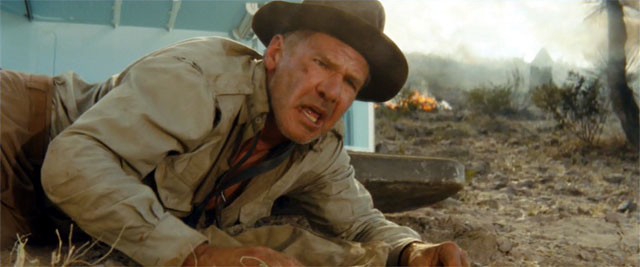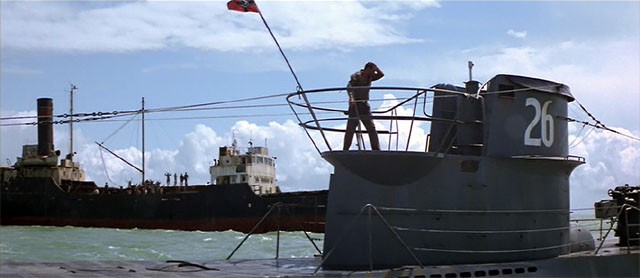
Personally, as a die-hard Indiana Jones fan, I’m quite forgiving of a lot of the problems people have with the series (which shouldn’t be surprising, considering I will defend the Star Wars prequels as well). Still, I cannot deny some of the goofy things that happened in the fourth installment six years ago.
I’m not just speaking of Shia LaBeouf’s Tarzan-like swings from jungle vines (that kid makes a career out of stealing other people’s shticks), but also the dreaded nuking of the fridge.
This got me thinking… was nuking the fridge really the most ridiculous thing that happened in the Indiana Jones series?
The Answer: Not really. It’s all impossible.
If you don’t remember exactly what happened in the beginning of Indiana Jones and the Kingdom of the Crystal Skull, here’s a quick summary: After Indy is captured by Russians in Area 51, he escapes and takes a high-speed rocket car out of the warehouse. He stumbles away and walks most of the night to find a quaint little town in the middle of the Nevada desert. However, he soon realizes he is in a fake town set to undergo an A-bomb test. To save himself, he climbs in a lead-lined refrigerator and is subsequently blasted miles away by the atomic bomb, landing safely next to a prairie dog on the downslope of a hill.
Of course there’s all sorts of crazy going on in this scene, and very little of it is actually possible. One can assume that Indy stumbled onto a site of Operation Plumbbob, which was a series of A-bomb tests by the U.S. military in 1957. While it’s not possible to determine the actual yield of the bomb dropped in the scene, those used in Operation Plumbbob ranged from 10 tons to 74 kilotons. Especially if this bomb was one of the bigger ones, this was definitely enough to lay waste to the town.
Even though Indy takes refuge in the lead-lined refrigerator, there’s more than just radiation he’d have to worry about. The heat of an atomic blast can reach temperatures in excess of 10,000 degrees Fahrenheit, which is evidenced by watching the mannequins in the fake town ignite. While any refrigerator is well insulated, it’s not designed to withstand temperature differences in the thousands of degrees.
There’s also the blunt impact that would have killed Indy inside the refrigerator. After all, we see the flying box overtake the car of Russians, which one can assume was fleeing away at a speed of at least 50 miles per hour. The refrigerator sails over the desert floor at least 100 feet in the air, bouncing all the way down Prairie Dog Hill. Unless that refrigerator was also lined in about six feet of foam rubber, he’d have been dead before he hit the ground a second time.
Even if Indy managed to survive the nuclear heat and the blunt impact, the radiation would actually have killed him. Lead-lined refrigerators have about 0.125 inches of lead shielding. At least 0.4 inches of shielding is required to cut radiation in half. That close to ground zero, Indy would have needed several inches of lead to not get massive radiation poisoning. (It’s a good thing he already fathered a child… or is it?)
So, yeah, absurd.
But was that the only time Indiana Jones went too far?
Not by a long shot. This character has been surviving impossible feats for years. Take, for example, the beginning of Indiana Jones and the Temple of Doom, in which Indy, Willie Scott (Kate Capshaw), and Short Round (Ke Huy Quan) parachute from a failing airplane on nothing but an inflatable life raft.
I’m not saying that it’s impossible to jump out of an airplane with a life raft and manage to hold on throughout the entire descent. I’m saying that if you did, you’d end up a stain on that raft.
The purpose of a parachute is to reduce the terminal velocity of a falling body, which is the maximum speed an object reaches when wind resistance cancels out the acceleration due to gravity. There’s no hard data on how high the plane was, or exactly how large the raft was, but considering the plane started to descent between 500 and 800 feet (according to its altimeter seen in the film), it is at least a couple hundred feet in the air when they jump.
A life raft plummeting to the ground horizontally will increase drag enough to slow things down, but not nearly as much as would be needed. In fact, if you assume all three people on that raft weigh a combined 150 kilograms, the raft is about 1 meter in diameter, and the raft yields a generous drag coefficient of an average parachute (which is 0.75), they would reach a terminal velocity of 36 meters per second, or 80 miles per hour. (Incidentally, the same effect would be reached moments later when they fall of a 100-foot cliff and crash land in the rapids.)
Whether you land on a snowy hill or in a body of water, you’re still dead. Hitting either snow or water at 80 miles per hour is like hitting the ground at 80 miles per hour.

Those were the sequels! Raiders of the Lost Ark is perfect, isn’t it?
It’s less ridiculous, but not free from moments that would kill a person in the real world.
After Belloq (Paul Freeman) and the Nazis take back the Ark of the Covenant from the steamer that was transporting Indy and Marion (Karen Allen) back home, they pack up their U-boat and head off to a secret Island in the Aegean Sea. Fortunately, Indy manages to swim to the submarine and hitch a ride in order to stop the Nazis, rescue Marion, and save the day.

This is a common nitpick that people have with Raiders of the Lost Ark: Why doesn’t Indy drown?
One might assume that the U-boat never submerges on its way to the secret island. After all, World War II era submarines were not like modern nuclear subs today. They were limited not just in how deep they could dive, but also by how far and fast they could travel while submerged.
Of course, IMDb has an answer to this riddle, based on deleted scenes and parts of the novelization: Indy held onto the parascope (which, for the most part, remains at the surface) while submerged, or clung to the hull when it sailed on the surface.
Sure, I’ll buy that. Except, this was a secret missions, and the Nazis were traveling to a secret island. According to the map in the film, their journey begins in the middle of the Mediterranean Sea and ends in the Greek Islands. While Greece was famously occupied by the Axis powers during World War II, that didn’t happen until 1941, while Raiders of the Lost Ark takes place five years earlier. It seems unlikely that a super-secret mission by the Nazis over the course of hundreds of miles would not require a least one dive.
Plus, at the maximum speed of a World War II era German U-boat (16 knots while surfaced or 9 knots while submerged), this journey would take dozens of hours.
Surviving a day-long voyage in water temperatures that would likely give him hypothermia, is almost as unlikely as parachuting with a life raft of surviving a nuclear blast in a refrigerator. Turns out that head-slapping survival moment was really only par for the course.
Click here to solve More Movie Mysteries
Related Topics: Harrison Ford, Indiana Jones
